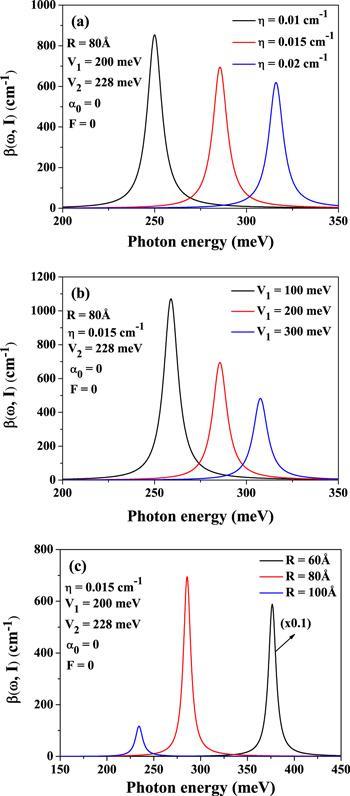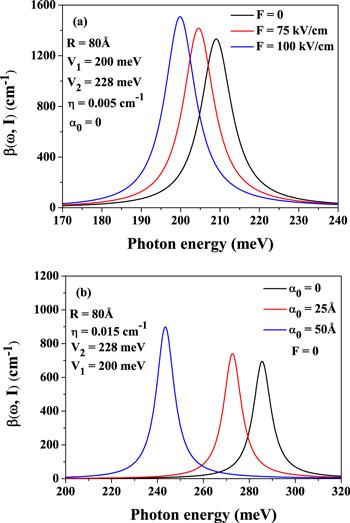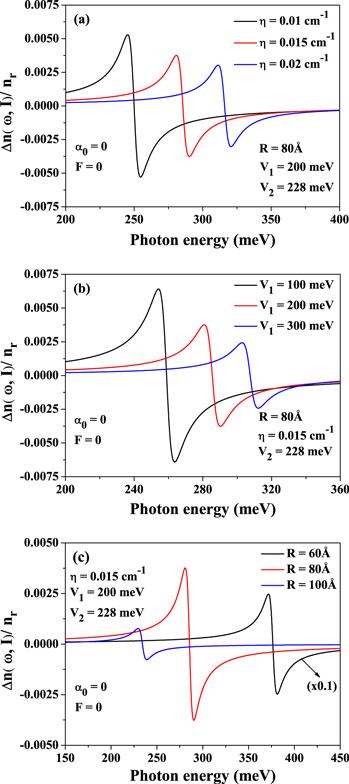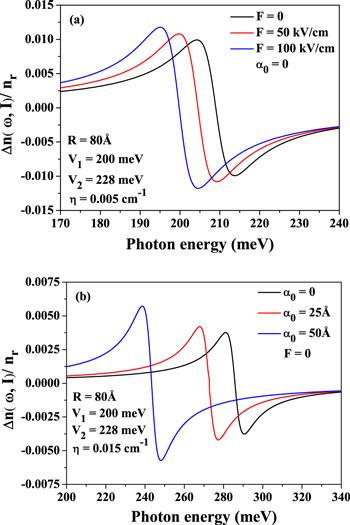 ,1, M K Bahar2, S Pal3, M E Mora-Ramos4,51Faculty of Technology, Department of Optical Engineering,
,1, M K Bahar2, S Pal3, M E Mora-Ramos4,51Faculty of Technology, Department of Optical Engineering, 2Faculty of Science, Department of Physics,
3Department of Quality Assurance, CQA(SA), DGQA Ichapur-Nawabganj, 24 Pgs(North), 743144, West Bengal,
4Centro de Investigación en Ciencias, Instituto de Investigación en Ciencias Básicas y Aplicadas,
5Facultad de Ciencias Básicas,
Received:2020-01-30Revised:2020-03-20Accepted:2020-03-30Online:2020-06-24

Abstract
Keywords:
PDF (759KB)MetadataMetricsRelated articlesExportEndNote|Ris|BibtexFavorite
Cite this article
F Ungan, M K Bahar, S Pal, M E Mora-Ramos. Electron-related nonlinear optical properties of cylindrical quantum dot with the Rosen–Morse axial potential. Communications in Theoretical Physics, 2020, 72(7): 075505- doi:10.1088/1572-9494/ab8a1d
1. Introduction
Owing to rapid advancement in the field of nanotechnology during the past few decades, low-dimensional semiconductor structures have attracted a great deal of interest for applications in modulating optoelectronic devices. Among these nanosystems, quantum dots (QDs) are characterized by the three-dimensional spatial confinement of charge carriers. This feature causes a discrete atomic-like energy state, thus making QDs promising candidates in manufacturing new-generation optoelectronic devices. Among other advantages, these structures exhibit more pronounced nonlinear optical effects than the bulk materials [1, 2]. Such resemblance of carrier energy spectrum with that of an atom allows us to speak about a QD as an artificial atom. Because of the vast innovative physical properties of QDs, a large number of theoretical and experimental studies on the linear and nonlinear optical responses of these systems have been carried out. It is possible to mention, for example, the theoretical optical absorption coefficient (OAC) and refractive index change (RIC) coefficients; the nonlinear optical rectification (NOR), the second and third harmonic generation (SHG and THG), as well as the so-called electro optic effect (EOE), are investigated in several studies [3–14].The description of electron states in QDs aligned with the direction of growth corresponds to the envelope function approximation, whose extension matches well with the width of the potential applied. Therefore, a number of researchers have taken interest in the nonlinear optical properties of QDs under the influence of several potentials with different potential shapes such as Coulomb, Rosen–Morse, Pöschl-Teller, Tietz-Hua, Woods-Saxon, Gaussian, Ellipsoidal and other potentials [15–31]. As the orbital wave functions of QDs are spatially extended they are susceptible to be influenced by external fields. Application of an external electromagnetic field in the direction of growth of the heterostructure modifies the quantized energy states of QDs by polarization of the carrier distribution [32]. The intensity output of the optoelectronic devices can be modulated considerably by monitoring the external fields. Therefore, several studies of external electromagnetic fields affecting linear and nonlinear optical properties of QDs have been conducted [11, 33–38]. As a summary, the presence of external perturbations in the form of static electric and magnetic fields, as well as that of the ILF, can play important roles in fabricating optical transition energy configurations, by tailoring confinement strength of the electron in QDs.
In this work, we have explored the detailed linear and third-order nonlinear optical responses in a cylindrical quantum dot (CQD) with Rosen–Morse axial potential, with the use of the numerical diagonalization of the associated Hamiltonian matrix. The calculations are done within the effective mass and parabolic band (EM+PB) theoretical frameworks. Based on this connection, additionally the influence of ILF and static electric field on the optical responses has also been investigated. The organization of the paper is as follows: the next section briefly presents the description of the theoretical modeling. In section
2. Theory
Here, we provide some details of the method for obtaining the electron subband energy levels and their related wave-functions of the CQD with Rosen–Morse axial potential, considering the influence of static electric field and ILF. The latter has polarization parallel to the growth (z) direction of the structure. Besides, the static electric field orients parallel to the z-direction. Under EM+PB, the Hamiltonian of a conduction band electron, confined within the CQD without ILF effects is using cylindrical coordinates given by [39]The process that allows us to determine the energy levels, Ez, and the corresponding z-dependent wave functions, g(z), consists of the diagonalization of the Hamiltonian matrix obtained after the expansion of the electron states in a series of a complete orthogonal basis. We choose as the elements of this basis the set of eigenfunctions of the infinite potential well of width Lb. The suitable value of Lb ensures the convergence of the bound energy levels, which is significantly larger than the dimensions of the active system. Such a calculation scheme has been used in our previous study [43]. With the energy eigenvalues and corresponding envelope wave functions at hand, we evaluated the linear and nonlinear optical coefficients from [44, 45]:
The total OAC, β(ω, I), and RRIC,
3. Results and discussion
In this study, we present the calculated results of the effect of static electric and non-resonant high-frequency intense THz laser fields on the TOAC and RRIC in a GaAs-based CQD with Rosen–Morse axial potential. In our calculations, the input parameters are:The values of calculated energy difference E10 and inter-state electric dipole moment matrix element M10 for different structural and external field configurations are reported in table 1. Figures 1(a)–(c) exhibit the variation of TOACs in the cylindrical QD with the Rosen–Morse axial potential as a function of incident photon energy for three distinct values of η, V1 and R respectively in the absence of ILF and static electric field. From figure 1(a), it is evident that as the width of the potential well (η) increases, the resonant energies of TOACs undergo a blue-shift which in turn signifies enhanced energy differences, related to transitions between the ground and first excited energy levels of the electron confined in the quantum well. The rise in the energy gap with the decrease of the confinement potential width is attributed by the greater repulsive interaction between the Rosen–Morse potential and the confined electron. On the contrary, the height of the TOACs peak diminishes with the increasing η value as a result of degradation of geometrical factor M10. Consequently, the spatial overlap of the wave-functions of the two states is lowered. Figure 1(b) demonstrates the influence of the Rosen–Morse potential on TOACs, when keeping other parameters at a constant value as described in the figure. A clear blue-shift of absorption peak position is obtained with the increasing value of V1. When potential strength increases, the electron suffers from greater confinement leading to an increase in the separation of energy levels of the electron. Additionally, with the increase in potential, the wave functions of individual energy states become more localized resulting in diminishing the values of the geometrical factor. As a result, the TOACs peak height gradually decreases with the increasing V1. Figure 1(c) explicitly reveals the behavior of TOACs with QD radius. As the QD radius increases, the energy separation between the two lowest allowed levels also decreases, which is reflected as red-shift of peak position of TOACs. In this case the resonant peak height first increases with the increase of QD radius, although it is evident from table 1 that the geometrical factor M10 evinces a sharp decrease from
Figure 1.
 New window|Download| PPT slide
New window|Download| PPT slideFigure 1.The variations of TOACs in the cylindrical QD with the Rosen–Morse axial potential as a function of incident photon energy for three different structure parameters of (a) η, (b) V1, and (c) R.
Table 1.
Table 1.The variation of electron subband energy differences and the dipole moment matrix elements associated to these subband energy differences for the cylindrical QD with the Rosen–Morse axial potential.
| η (cm−1) ( | M10 (Å) | |
| 0.01 | 249.938 | 13.7334 |
| 0.015 | 285.52 | 11.5751 |
| 0.02 | 315.988 | 10.3795 |
| V1 ( meV) ( | M10 (Å) | |
| 100 | 258.905 | 15.1299 |
| 200 | 285.52 | 11.5751 |
| 300 | 307.553 | 9.285 19 |
| R (Å) ( | M10 (Å) | |
| 60 | 376.469 | 29.9553 |
| 80 | 285.52 | 11.5751 |
| 100 | 234.154 | 5.227 33 |
| F (kV/ cm) ( | M10 (Å) | |
| 0 | 208.989 | 18.8477 |
| 75 | 204.51 | 19.675 |
| 100 | 199.82 | 20.5504 |
| α0 (Å) ( | M10 (Å) | |
| 0 | 285.52 | 11.5751 |
| 25 | 272.596 | 12.2331 |
| 50 | 243.354 | 14.2881 |
New window|CSV
Figures 2(a)–(b) depict the variations of TOACs in the CQD with the Rosen–Morse axial potential as a function of incident photon energy for three different values of static electric field and ILF parameters, respectively. From figure 2(a), it is prominent that as electric field intensifies TOACs exhibit a red-shift with gradual increase in the peak height. From table 1, it can be explained that as the electric field increases, the energy separation between the ground state and first excited state decreases, whereas the geometrical factor M10 enhances with increasing electric field. When the electric field is accelerated, the role of the Rosen–Morse potential starts to be faded out, which eventually makes the electron less confined. As a result, the wave functions of energy levels of the electron become more delocalized. Figure 2(b) also announces almost the same behavior as revealed in figure 2(a). Here, as ILF parameter (α0) increases, TOACs exhibit a red-shift with rise in the peak height. The observation can be explained in light of diminishing impact of the Rosen–Morse potential on the electron in QD when ILF is switched on and enhanced gradually. As ILF increases, the overlap between the wave functions of the first two energy states is also increased due to the close proximity of the energy levels. This is the main cause of the red-shift of the TOACs, as well as of the increment in resonant peak amplitude with increasing ILF.
Figure 2.
 New window|Download| PPT slide
New window|Download| PPT slideFigure 2.The variations of TOACs in the cylindrical QD with the Rosen–Morse axial potential as a function of incident photon energy for three different values of (a) static electric field and (b) ILF parameters.
Figures 3(a)–(c) explicitly delineate the variation of RRICs in the CQD with the Rosen–Morse axial potential as a result of the increase of the incident photon energy. This appears for three different values of
Figure 3.
 New window|Download| PPT slide
New window|Download| PPT slideFigure 3.The variations of RRICs in the cylindrical QD with the Rosen–Morse axial potential as a function of incident photon energy for three different structure parameters of (a) η, (b) V1, and (c) R.
Figures 4(a)–(b) contain the dependence of RRICs in the CQD with the change of the Rosen–Morse axial potential, plotted as a function of energy of incoming light, for three different values of static electric field and ILF parameters, respectively. As the ILF increases, the RRICs go through a sharp red-shift due to the reduction of the difference of energy between the ground and first excited states. On the contrary, the geometrical factor enhances with increasing ILF, which is manifested as the increasing peak height of RRICs. Actually, when the system is perturbed with ILF it is fed with excess electrons, which in turn brings a repulsive interaction with the confined electron. Such repulsive interaction delocalizes the wave-functions of individual energy states. As a result, the superposition of energy states is accelerated enhancing the geometrical factor. Figure 4(a) promulgates the same behavior of RRICs when it is tailored at three increasing static electric fields. The static electric fields also enrich the QD system with excess electrons, which brings about a repulsive interaction with the electron confined in the Rosen–Morse potential. As a result the energy differences between the two states gradually diminishes resulting in a sharp enhancement in the geometrical factor M10. Here, the RRICs undergo a red-shift with increasing electric field manifesting a rise in peak height.
Figure 4.
 New window|Download| PPT slide
New window|Download| PPT slideFigure 4.The variations of RRICs in the cylindrical QD with the Rosen–Morse axial potential as a function of incident photon energy for three different values of (a) static electric field and (b) ILF parameters.
4. Conclusions
In conclusion, the total optical absorption and relative refractive index change coefficients of a CQD under the confinement of the Rosen–Morse axial potential, with the interplay of non-resonant intense laser and static electric field, are investigated. Both cases of optical response undergo a blue-shift with the increasing strength of the potential well due to an increase in energy separation between the ground state and first excited state, whereas the peak height gradually decreases with the increasing potential well width and strength, which can be attributed as a result of localization of wave-functions. The effect of the changes in the QD radius on total optical absorption and relative refractive index change coefficients is not straightforward. These coefficients delineate a red-shift with the increasing QD radius as a result of closeness of energy levels. The peak height first escalates with increase in radius, and then suddenly falls in a drastic manner with its further enhancement. Similarly, the influence of the intense laser and static electric fields on the studied optical coefficients is very prominent. Both properties exhibit a red-shift with increasing field intensities. The peak height, on the other hand, escalates with the increasing laser and static electric fields. Therefore, the present theoretical model sheds light on the qualitative and quantitative influences of the Rosen–Morse confining potential in conjunction with intense laser and static electric fields on the nonlinear optical properties of QDs.Acknowledgments
MEMR is grateful to Universidad de Medellín for hospitality and support during their 2019–2020 sabbatical stay. He also acknowledges support from Mexican CONACYT through research Grant A1-S-8218.Reference By original order
By published year
By cited within times
By Impact factor
[Cited within: 1]
[Cited within: 1]
DOI:10.1016/S0921-4526(01)01562-9 [Cited within: 1]
DOI:10.1016/j.spmi.2009.12.002
DOI:10.1016/j.solidstatesciences.2011.05.016
DOI:10.1016/j.spmi.2012.09.014
DOI:10.1590/S0103-97332006000300031
DOI:10.1002/pssb.200880516
DOI:10.1016/j.solidstatesciences.2012.01.020
DOI:10.1140/epjb/e2010-10556-3
DOI:10.1016/j.ssc.2005.06.001 [Cited within: 1]
DOI:10.1016/j.jlumin.2011.03.044
DOI:10.1007/s11082-016-0640-9
DOI:10.1016/j.jpcs.2015.10.002 [Cited within: 1]
DOI:10.1016/j.physe.2007.08.013 [Cited within: 1]
DOI:10.1063/1.3225100
DOI:10.1016/j.ssc.2006.07.012
DOI:10.1134/S0030400X14090100
DOI:10.1016/j.spmi.2013.11.001
DOI:10.1016/j.physleta.2012.04.028
DOI:10.1016/j.physe.2012.04.005
DOI:10.1016/j.physe.2010.08.007
DOI:10.1016/j.physe.2012.10.018
DOI:10.1016/j.cap.2010.07.002
DOI:10.1016/j.physe.2009.11.122
DOI:10.1007/s12043-014-0906-3
DOI:10.1016/j.optcom.2011.05.033
DOI:10.1016/j.spmi.2014.09.036
DOI:10.1016/j.jlumin.2011.06.051
DOI:10.1016/j.spmi.2009.06.013
DOI:10.1016/j.physe.2014.01.034 [Cited within: 1]
DOI:10.1016/j.physleta.2006.01.107 [Cited within: 1]
DOI:10.1016/j.physb.2010.05.019 [Cited within: 1]
DOI:10.1016/j.physleta.2007.09.075
DOI:10.1063/1.2904860
DOI:10.1166/jctn.2009.1020
DOI:10.1016/j.spmi.2010.06.008
DOI:10.1088/0953-8984/19/39/395024 [Cited within: 1]
DOI:10.1142/S0217979204026238 [Cited within: 1]
[Cited within: 1]
DOI:10.1139/P09-083 [Cited within: 1]
DOI:10.1063/1.336555 [Cited within: 1]
DOI:10.1016/j.physe.2014.03.024 [Cited within: 1]
[Cited within: 1]
DOI:10.1002/pssb.200562461 [Cited within: 1]
